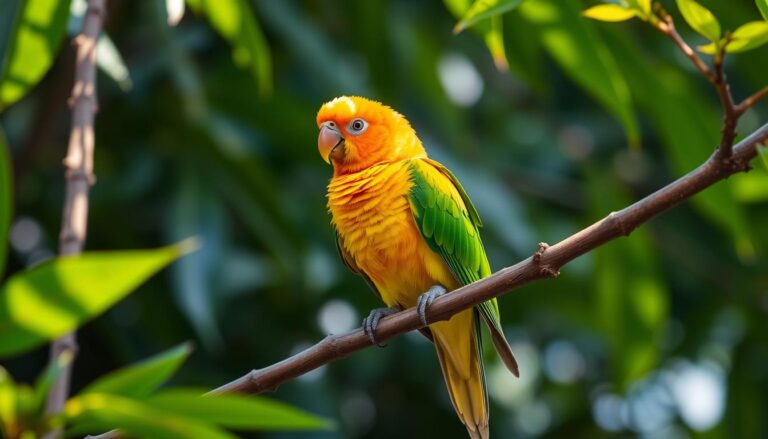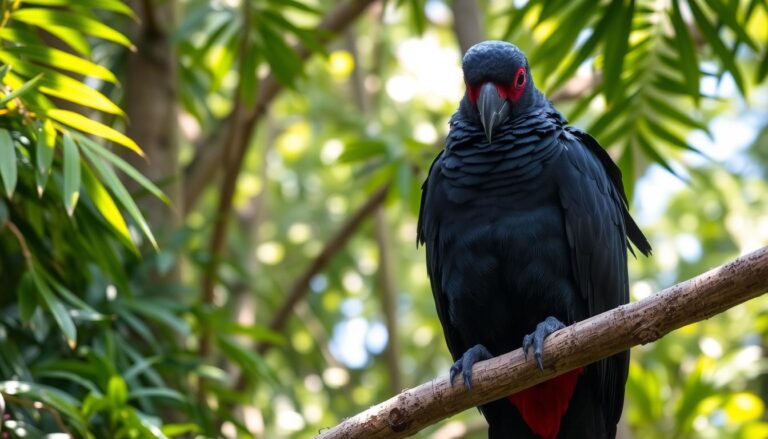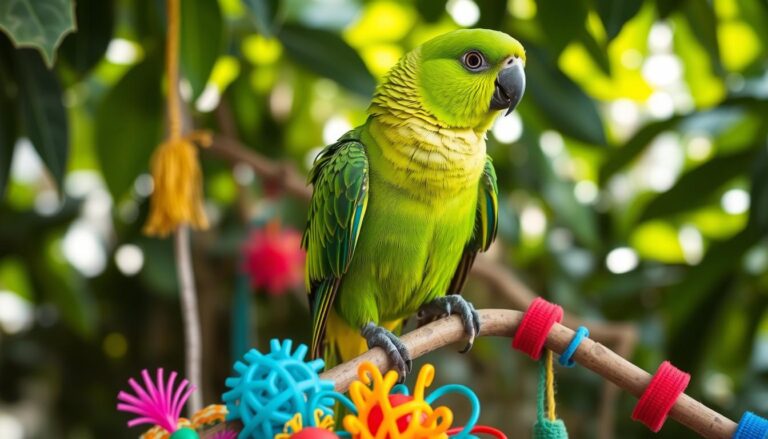Scarlet Macaw: Your Guide to This Stunning Parrot
The scarlet macaw soars high in Central and South America’s vibrant rainforests. It’s known for its bright red feathers, making it a standout among birds. Birdwatchers and animal lovers find it fascinating.
The scarlet macaw is a symbol of beauty and resilience. It represents the wonders of nature. This guide will help you understand these amazing birds, whether you want to see them in the wild or keep one as a pet.
Key Takeaways
- The scarlet macaw is one of the most iconic and recognizable parrots in the world, known for its vibrant red plumage.
- These birds are native to the tropical rainforests of Central and South America, where they play a vital role in the ecosystem.
- Scarlet macaws are highly social and intelligent animals, with complex communication methods and flock dynamics.
- While they make engaging companion pets, scarlet macaws require specialized care, training, and a significant time commitment.
- Conserving the scarlet macaw’s natural habitat is crucial to ensuring the long-term survival of this magnificent species.
Introduction to the Magnificent Scarlet Macaw
The scarlet macaw is a stunning parrot known for its bright colors and amazing flying skills. This bird, called Ara macao scientifically, is a wonder of nature. It captures the hearts of wildlife lovers everywhere.
Found in the rainforests of Central and South America, the scarlet macaw is a sight to see. Its red, yellow, and blue feathers stand out among other birds. With a wingspan up to 3.3 feet, it glides through the trees with ease.
Scarlet macaws also hold a special place in many cultures. They are seen in art, myths, and rituals. People love to see them in aviaries, where they can watch their bright colors and interesting behaviors.
“The scarlet macaw is a true embodiment of the natural world’s beauty and grace. Its vibrant plumage and impressive flight capabilities make it a unique and awe-inspiring creature.”
As we learn more about the scarlet macaw, we’ll see its unique looks, where it lives, and its interesting ways. This parrot is truly a remarkable bird.
Physical Characteristics and Appearance
The scarlet macaw is a stunning bird known for its vibrant and distinctive color patterns. It has brilliant red, yellow, and blue feathers. This parrot stands out in any environment with its sizeable stature and impressive wing span.
Distinctive Color Patterns
The scarlet macaw’s feathers are a mesmerizing blend of deep red, bright yellow, and rich blue. This captivating combination creates a visually striking appearance. The bird’s wings, tail, and body are covered in these vivid hues, making it a true feast for the eyes.
Size and Body Structure
Scarlet macaws are sizable birds, typically measuring between 32 and 37 inches in length from beak to tail. Their impressive wingspan can reach up to 40 inches, allowing them to take to the skies with ease. These parrots have a robust, muscular build and a distinctive curved beak that is well-suited for cracking nuts and seeds.
Beak and Wing Span
The scarlet macaw’s beak is a remarkable feature, with a strong, curved shape that is perfectly adapted for its diet. This powerful tool helps the bird efficiently break through tough shells and extract the nutritious contents. Similarly, their expansive wing span enables them to soar gracefully through the air, making them a sight to behold in their natural habitat.
Natural Habitat and Distribution
The scarlet macaw is a vibrant parrot that lives in the lush rainforests of Central and South America. These birds thrive in the green forests from Mexico to Peru. They play a key role in keeping the ecosystem balanced.
Scarlet macaws live in the upper canopy of these forests. They find plenty of fruits, nuts, and seeds to eat. Their strong beaks and agile talons help them forage among the tall trees. This helps spread seeds and grow new trees.
The scarlet macaw’s home is facing danger from deforestation and habitat loss. As forests are cleared for farming, cities, and mining, their numbers are going down. This has made them a near-threatened species, according to the International Union for Conservation of Nature (IUCN).
Conservationists and groups are fighting to save the scarlet macaw’s home. They know these forests are vital for the bird’s survival and for the planet’s health. By protecting the scarlet macaw habitat, we can keep these amazing birds and the rich biodiversity they bring.
“The scarlet macaw is a symbol of the richness and fragility of the tropical rainforest ecosystems. Protecting their habitat is crucial for the survival of this species and the preservation of the entire ecosystem.”
Behavior and Social Structure in the Wild
Scarlet macaws are known for their bright colors. But their social behavior and life in the wild are just as fascinating. These parrots have a complex way of communicating, interact with each other in interesting ways, and follow daily routines.
Communication Methods
Scarlet macaws are very vocal. They use different sounds to talk to each other. They make loud squawks, screeches, and chirps to share messages. They also use body language like wing-flapping and head-bobbing to add to their communication.
Flock Dynamics
Scarlet macaws live in close groups. These groups have a leader who makes decisions and decides who gets what. The birds stay together by grooming, preening, and playing. This builds a strong community and helps them work together.
Daily Routines
- Scarlet macaws wake up early to start their day.
- They spend the day flying in big, colorful groups, looking for food.
- In the afternoon, they rest in the trees, preening and relaxing. Then, they socialize and roost together in the evening.
The scarlet macaw’s behavior and social life in the wild are truly amazing. By studying how they communicate, interact, and live their days, we can better understand these incredible birds.

Diet and Feeding Habits
The scarlet macaw is a colorful and fascinating parrot. It eats a wide variety of seeds, nuts, fruits, and plants in the wild. This shows how well they adapt and forage.
Scarlet macaws are great at finding and getting to different foods in their homes. They use their strong, hooked beaks to crack open tough nuts and seeds, extracting the nutrient-rich kernels inside. They also love the sweet pulp and juices of tropical fruits. This helps keep their bright colors and keeps them healthy.
Scarlet macaws also have special ways of finding food. They often work in coordinated flocks, with individuals taking turns accessing the most desirable feeding spots. This way, everyone gets a fair share and it helps them stay together.

The scarlet macaw’s diet is key to their stunning looks. The carotenoids and other nutrients in their food make their feathers bright red, blue, and yellow. By choosing what they eat carefully, they keep their feathers looking amazing.
- Scarlet macaws primarily feed on a diverse range of seeds, nuts, fruits, and vegetation
- They use their strong, hooked beaks to crack open tough nuts and seeds
- Scarlet macaws often forage in coordinated flocks, ensuring an equitable distribution of resources
- Their diet plays a crucial role in maintaining their stunning and vibrant plumage
The scarlet macaw’s eating habits and foraging skills show how adaptable they are. They play a big role in keeping their ecosystems balanced. By learning about their eating ways, we can appreciate their importance in nature.
Lifespan and Health Considerations
The scarlet macaw can live over 50 years in captivity. To keep them healthy, owners must provide careful care and attention.
Common Health Issues
Scarlet macaws face health problems like feather-plucking, respiratory infections, and digestive issues. It’s crucial to take them to the vet regularly. This helps catch and treat problems early.
Preventive Care Tips
- Feed them a balanced diet with fresh fruits, veggies, and quality pellets.
- Keep their environment clean, well-ventilated, and draft-free.
- Make sure they get enough exercise and mental stimulation to avoid boredom and stress.
- Trim their nails and beak when needed to keep them groomed and prevent overgrowth.
Veterinary Requirements
Scarlet macaws need regular vet visits, every 6 to 12 months. This helps monitor their health and catch any issues early. It’s important to find an avian vet experienced in caring for these birds.
| Veterinary Procedure | Frequency |
|---|---|
| Physical Examination | Every 6-12 months |
| Feather and Nail Trimming | As needed |
| Preventive Vaccinations | As recommended by your veterinarian |
| Parasite Screening and Treatment | Annually or as needed |
By following these guidelines and working with a skilled avian vet, owners can ensure their scarlet macaws live long, healthy lives.

Keeping a Scarlet Macaw as a Pet
Owning a scarlet macaw is a big responsibility. These birds are not like regular pets. They have special needs that must be met to keep them happy and healthy.
One key thing to think about is how much space a scarlet macaw needs. They need lots of room to fly, climb, and play. A big, airy aviary or a bird-proofed room is a must.
Scarlet macaws also have specific food needs. They need a mix of high-quality pellets, fresh fruits, veggies, and treats. Giving them the right food is important for their health and life span.
Thinking about the time and money needed to care for a scarlet macaw is important. These birds can live for 40 to 60 years. This means a big commitment. Costs for vet visits, toys, and food can add up fast.
Before getting a scarlet macaw for sale, you should check the laws and ethics of owning one. In some places, you might need special permits. It’s important to follow all the rules.
| Factors to Consider | Requirements |
|---|---|
| Housing | Spacious aviary or large, bird-proofed room |
| Diet | High-quality pellets, fresh fruits, vegetables, and occasional treats |
| Time and Financial Commitment | Lifelong commitment, regular veterinary care, specialized toys, and high-quality food |
| Legal and Ethical Considerations | Research local regulations and ensure responsible ownership |
Deciding to keep a scarlet macaw as a pet is serious. These birds need special care, a lot of money, and a big commitment from their owners. Making an informed decision is key when thinking about getting a scarlet macaw for your family.
Training and Socialization Requirements
Scarlet macaws are very smart birds that need lots of training and socializing. Building a strong bond with your pet macaw is key. It ensures their happiness and makes them easier to train.
Basic Commands
Teaching your scarlet macaw basic commands like “step up,” “down,” and “stay” is important. Positive methods, such as treats or praise, work best. They help your bird learn and trust you more.
Behavioral Management
Scarlet macaws are playful but can be a bit naughty. It’s important to manage their behavior well. Give them lots of mental and physical activities to keep them happy and healthy.
Social Needs
Scarlet macaws love being around people and need lots of attention. Make sure they get enough time with their family. This keeps them happy and strengthens your bond with them.
FAQ
What is the lifespan of a scarlet macaw?
How much do scarlet macaws typically cost?
FAQ
What is the lifespan of a scarlet macaw?
Scarlet macaws can live a long time, over 50 years in captivity. In the wild, they live about 40-50 years on average.
How much do scarlet macaws typically cost?
The cost of a scarlet macaw varies a lot. It can be from
FAQ
What is the lifespan of a scarlet macaw?
Scarlet macaws can live a long time, over 50 years in captivity. In the wild, they live about 40-50 years on average.
How much do scarlet macaws typically cost?
The cost of a scarlet macaw varies a lot. It can be from $1,000 to $12,000 or more. This depends on the bird’s age, health, and where it comes from. It’s key to find a reputable breeder and think about the ongoing costs of owning these birds.
Where do scarlet macaws live in the wild?
Scarlet macaws live in the tropical rainforests of Central and South America. Their home ranges from Mexico to Peru. They need tall trees, lots of food, and little human disturbance to thrive.
Can scarlet macaws fly?
Yes, scarlet macaws are great flyers. They have strong wings and are known for their aerial stunts. They can soar high or swoop low through the trees.
What are some interesting facts about scarlet macaws?
Scarlet macaws are famous for their bright red, yellow, and blue feathers. They are very smart and can mimic human speech. They also have strong social bonds and play key roles in their ecosystems as pollinators and seed dispersers.
Can I keep a scarlet macaw as a pet?
Keeping a scarlet macaw as a pet is a big commitment. They are very social and need lots of training, socialization, and mental stimulation. Before getting one, think carefully about the legal, ethical, and practical aspects.
How do I care for a scarlet macaw?
To care for a scarlet macaw, you need a big aviary, a special diet, and regular vet visits. They need lots of interaction, training, and mental games to stay healthy and happy. Proper socialization and behavior management are key for their well-being.
,000 to ,000 or more. This depends on the bird’s age, health, and where it comes from. It’s key to find a reputable breeder and think about the ongoing costs of owning these birds.
Where do scarlet macaws live in the wild?
Scarlet macaws live in the tropical rainforests of Central and South America. Their home ranges from Mexico to Peru. They need tall trees, lots of food, and little human disturbance to thrive.
Can scarlet macaws fly?
Yes, scarlet macaws are great flyers. They have strong wings and are known for their aerial stunts. They can soar high or swoop low through the trees.
What are some interesting facts about scarlet macaws?
Scarlet macaws are famous for their bright red, yellow, and blue feathers. They are very smart and can mimic human speech. They also have strong social bonds and play key roles in their ecosystems as pollinators and seed dispersers.
Can I keep a scarlet macaw as a pet?
Keeping a scarlet macaw as a pet is a big commitment. They are very social and need lots of training, socialization, and mental stimulation. Before getting one, think carefully about the legal, ethical, and practical aspects.
How do I care for a scarlet macaw?
To care for a scarlet macaw, you need a big aviary, a special diet, and regular vet visits. They need lots of interaction, training, and mental games to stay healthy and happy. Proper socialization and behavior management are key for their well-being.







